Steamtown National Historic Site
Steamtown National Historic Site (NHS) is a railroad museum and heritage railroad located on 62.48 acres (25.3 ha)[2] in downtown Scranton, Pennsylvania, at the site of the former Scranton yards of the Delaware, Lackawanna and Western Railroad (DL&W). The museum is built around a working turntable and a roundhouse that are largely replications of the original DL&W facilities; the roundhouse, for example, was reconstructed from remnants of a 1932 structure. The site also features several original outbuildings dated between 1899 and 1902. All the buildings on the site are listed with the National Register of Historic Places as part of the Delaware, Lackawanna and Western Railroad Yard-Dickson Manufacturing Co. Site.[3][4]
| Steamtown National Historic Site | |
|---|---|
IUCN category III (natural monument or feature) | |
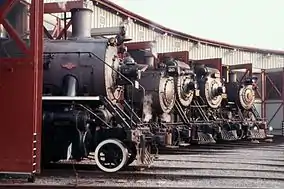 Five locomotives in the roundhouse | |
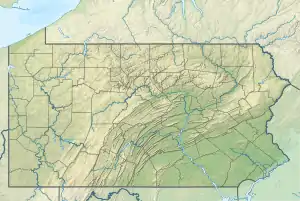  | |
| Location | Scranton, Pennsylvania, USA |
| Coordinates | 41°24′26″N 75°40′17″W |
| Area | 62.48 acres (25.28 ha) |
| Established | October 30, 1986 |
| Visitors | 106,309[1] (in 2005) |
| Governing body | National Park Service |
| Website | Steamtown National Historic Site |
Most of the steam locomotives and other railroad equipment at Steamtown NHS were originally collected by F. Nelson Blount, a millionaire seafood processor from New England. In 1964, Blount established a non-profit organization, the Steamtown Foundation, to operate Steamtown, U.S.A., a steam railroad museum and excursion business in Bellows Falls, Vermont. In 1984, the foundation moved Steamtown to Scranton, conceived of as urban redevelopment and funded in part by the city. But the museum failed to attract the expected 200,000 to 400,000 annual visitors, and within two years was facing bankruptcy.[5]

In 1986, the U.S. House of Representatives, at the urging of Scranton native Representative Joseph M. McDade, approved $8 million to begin turning the museum into a National Historic Site.[6] The idea was derided by those who called the collection second-rate, the site's historical significance questionable, and the public funding no more than pork-barrel politics.[7][8] But proponents said the site and the collection were ideal representations of American industrial history.[9] By 1995, the National Park Service (NPS) had acquired Steamtown, USA, and improved its facilities at a total cost of $66 million.
Steamtown National Historic Site has since sold a few pieces from the Blount collection, and added a few others deemed of greater historical significance to the region. By 2008, low visitor attendance and the need of costly asbestos removal from many pieces of the collection were spurring discussion about privatizing Steamtown.[10]
Museum and collection

Steamtown NHS is located within a working railroad yard and incorporates the surviving elements of the 1902 DL&W Scranton roundhouse and locomotive repair shops. The visitor center, theater, technology and history museums are built in the style of and on the site of the missing portions of the original roundhouse, giving an impression of what the original circular structure was like.[11][12]
The museum has exhibits about the history and technology of steam railroads in the United States and Pennsylvania, particularly the DL&W; life on the railroad; and the business, labor, and governmental relationships between railroads.[11] The theater shows a short film throughout the day.[12]
Many locomotives and freight and passenger cars are on display. Some have open cabs and compartments that visitors can climb in and walk through, including a mail car, railroad executives' passenger car (with dining room and sleeping / lounge areas), a boxcar, two cabooses, and a recreated DL&W station with ticket window. A steam locomotive with cutaway sections helps visitors understand steam power. Part of one of the 1865 roundhouse inspection pits uncovered in archaeological excavations is also preserved in situ, under glass.[12]
Some of the rolling stock is historically connected to the site, including a DL&W steam engine and diesel, caboose, boxcar, a former World War II troop sleeper that the DL&W converted to maintenance of way service, and numerous passenger cars. Former Oneida & Western/Rahway Valley Railroad 2-8-0 engine #15 was overhauled by the DL&W. Other noteworthy pieces are the popular Union Pacific Big Boy #4012, Canadian Pacific Railway (CP Rail) #2929 (a rare Jubilee 4-4-4), Nickel Plate Road (NKP) S-2 #759, and Reading Company (RDG) T-1 #2124.[12]
Engines NKP #759, CN #47, New Haven Trap Rock Co. #43, and Rahway Valley #15 have operated at Steamtown, but not since the move to Pennsylvania.[12]
Locomotives
| Number | Heritage | Type | Builder | Status | Notes | Picture |
|---|---|---|---|---|---|---|
| 1 | Brooks-Scanlon Corporation | 2-6-2 | Baldwin, 1914 | Display |  | |
| 1 | Meadow River Lumber Company | Class B Shay | Lima, 1910 | Display | Damaged by building collapse in 1983. |  |
| 2 | Bullard Company | 0-4-0T | H.K. Porter, 1937 | Undergoing cosmetic restoration | Smallest locomotive in the collection. |  |
| 3 | E.J. Lavino and Company | 0-6-0T | ALCO, 1927 | Display |  | |
| 7 | Berlin Mills Railway | 2-4-2T | Vulcan Iron Works, 1911 | Display |  | |
| 8 | Spang, Chalfant & Co. | 0-6-0 | Baldwin, 1923 | Sectioned display |  | |
| 15 | Rahway Valley Railroad | 2-8-0 | Baldwin, 1916 | Display | Originally built for the Oneida and Western Railroad as 20, operated in Vermont. | .jpg.webp) |
| 26 | Baldwin Locomotive Works | 0-6-0 | Baldwin, 1929 | Operational | Runs on Scranton Limited. | .jpg.webp) |
| 43 | New Haven Trap Rock Company | 0-4-0T | Vulcan Iron Works, 1919 | Display | .jpg.webp) | |
| 44 | Nickel Plate Road | 4-6-0 | Brooks Locomotive Works, 1905 | Display | Oldest surviving Nickel Plate Road locomotive. | .jpg.webp) |
| 47 | Canadian National Railway | 4-6-4T | Montreal Locomotive Works, 1914 | Display | The first steam locomotive to pull excursion runs at Steamtown, prior to the move from Vermont. | 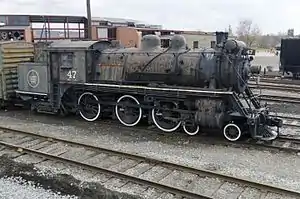 |
| 132 | Wabash Railroad | SW-8 | Electro-Motive Division, 1953 | Display | Painted as Lackawanna No. 500. | |
| 210 | Norwood & St. Lawrence Railroad | 2-6-0 | ALCO, 1923 | Display | .jpg.webp) | |
| 514 | Nickel Plate Road | GP-9 | Electro-Motive Division, 1958 | Operational |  | |
| 519 | Maine Central Railroad | 2-8-0 | ALCO, 1913 | Display | .jpg.webp) | |
| 565 | Delaware, Lackawanna and Western Railroad | 2-6-0 | ALCO, 1908 | Display | Only DL&W locomotive in the collection. | .jpg.webp) |
| 759 | Nickel Plate Road | 2-8-4 | Lima, 1944 | Display | Operated in excursion service between 1968 and 1973. | 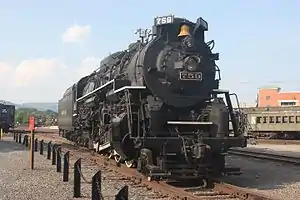 |
| 790 | Illinois Central Railroad | 2-8-0 | ALCO, 1903 | Display | Oldest locomotive in the collection. | .jpg.webp) |
| 1901 | Atlantic Coast Line Railroad | SW-1 | Electro-Motive Division, 1939 | Undergoing overhaul | ||
| 1923 | Lowville and Beaver River Railroad | 2-8-0 | ALCO, 1920 | Display | Built for Compañía Azucarera Central Reforma of Cuba as No. 8 but never delivered. | .jpg.webp) |
| 2124 | Reading Company | 4-8-4 | Reading Shops, 1947 | Display | Built from Reading I-10sa class 2-8-0 2044 | .jpg.webp) |
| 2317 | Canadian Pacific Railway | 4-6-2 | Montreal Locomotive Works, 1923 | Display, awaiting 1472-day overhaul/restoration | Operated in excursion service between 1978 and 2010. | 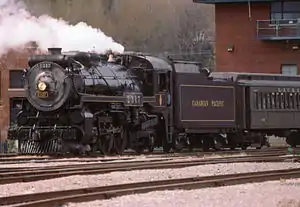 |
| 2505 | Delaware, Lackawanna and Western Railroad | Electric Multiple Unit | Pullman, 1930 | Display | Only piece of electric equipment in the collection. | |
| 3254 | Canadian National Railway | 2-8-2 | Canadian Locomotive Company, 1917 | Display | Operated in excursion service between 1987 and 2012. | 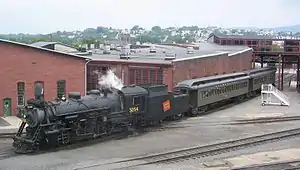 |
| 3377 | Canadian National Railway | 2-8-2 | Canadian Locomotive Company, 1919 | Display, awaiting possible operational restoration | Previously used as a parts source for sister No. 3254. | .jpg.webp) |
| 3713 | Boston and Maine Railroad | 4-6-2 | Lima, 1934 | Undergoing operational restoration | Named the "Constitution". | 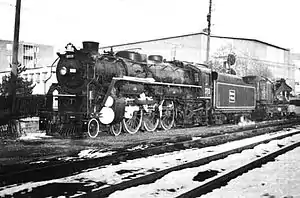 |
| 4012 | Union Pacific Railroad | 4-8-8-4 | ALCO, 1941 | Undergoing cosmetic restoration | Largest locomotive in the collection. |  |
| 6039 | Grand Trunk Western Railroad | 4-8-2 | Baldwin, 1925 | Display | .jpg.webp) | |
| 6816 | Public Service Electric and Gas Co. | 0-6-0F | H.K. Porter, 1923 | Display | Only fireless locomotive in the collection. | |
Engines sold by Steamtown NHS/Steamtown USA Foundation include Canadian Pacific 2816, the sole remaining non-streamlined Canadian Pacific 4-6-4 Hudson, which has been restored to working order and hauls trips for CP Rail; and Norfolk & Western 1218, which ran for the Norfolk Southern Railway Steam Program and now resides at the Virginia Museum of Transportation.[12]
Several engines not part of the collection have visited the Scranton site: NYS&W #142, BM&R #425(now Reading Blue Mountain and Northern 425), Lowville & Beaver River Shay #8, former RDG T-1 #2102 (under restoration by Reading Blue Mountain and Northern), Milwaukee Road 261, PRR 1361 and NKP 765.[12] "Peppersass" No.1 from Mount Washington Cog Railway visited the Steamtown Scranton site during Railfest 2016, and revisited again during March 11 to 13, 2019.
Demonstrations, tours, and excursions
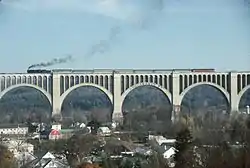
Steamtown NHS offers a variety of demonstrations, tours, and excursions that demonstrate how railroads functioned in the age of steam. Park rangers give guided tours of the locomotive shop, where one can see work being done on the steam engines in the original roundhouse area; the Union Pacific Big Boy locomotive on display; and demonstrations of the turntable on a regular basis. They also give talks on the history of Steamtown. The Scranton yard occupies about 40 acres (16 ha).
Several working locomotives take visitors on short excursions through the Scranton yard in the spring, summer, and fall. Most rides are on passenger coaches, but there are also caboose and handcar rides offered. These rides are included in the admission, although reservations may be required. Longer excursions are scheduled with separate tickets. These include a ride on a Pullman coach and longer trips to various nearby towns, including the Lackawanna River valley and Carbondale, Tobyhanna and Moscow, Pennsylvania. On rare occasions, excursions are run to the Delaware Water Gap, to Cresco, Pennsylvania, and East Stroudsburg, and Gouldsboro, Pennsylvania(stations are not listed in order of the line). Until 2012, Steamtown hosted RailCamp, a program put on by the National Railway Historical Society to educate future railroad employees and fans of the industry about railroad operation and preservation.[13]
History
New England roots
F. Nelson Blount, the heir to the largest seafood processor in the United States, was an avid railroad enthusiast. When he was 17, he wrote a book on steam power; later, he amassed one of the largest collections of vintage steam locomotives in the United States. By 1964, part of his collection — 25 steam locomotives from the United States and Canada, 10 other locomotives, and 25 pieces of rolling stock — was housed at North Walpole, New Hampshire.[14] The Monadnock, Steamtown & Northern Railroad, as the enterprise was then called,[15] ran excursions between Keene and Westmoreland, New Hampshire.[14]
After failing in 1962 to convince the State of New Hampshire to take over control of the bulk of the collection,[16] Blount established the "Steamtown Foundation for the Preservation of Steam and Railroad Americana" to operate Steamtown, USA in 1964. The non-profit, charitable, educational organization was to have nine un-salaried directors, including the five incorporators: Blount, former New Hampshire governor Lane Dwinell; Emile Bussiere; Robert L. Mallat Jr., mayor of Keene; and Bellows Falls Municipal Judge Thomas P. Salmon, who later became governor of Vermont. The president of the Campbell Soup Company, William B. Murphy, who had also served as National Chairman of Radio Free Europe, and the vice president of Blount Seafood, Fredrick Richardson, were among the other directors. The first order of business for the Steamtown Foundation was to acquire the Blount collection at North Walpole, and move it to property once owned by the Rutland Railroad, in Bellows Falls, Vermont.[14]
Blount was killed on August 31, 1967, when his private airplane hit a tree during an emergency landing, in Marlborough, New Hampshire.[17] By that time, a good deal of Blount's collection was controlled by the Steamtown Foundation and had been moved to Bellows Falls. One of Blount's corporations, the Green Mountain Railroad (GMRC), controlled the tracks that lay between Walpole, Bellows Falls and Chester, Vermont, which Steamtown was to use for its excursions. When Blount died, most of the controlling stock of the GMRC was transferred to the president of the railroad, Robert Adams.[18] By 1976, the relationship between Steamtown and GMRC was strained as the two organizations fought over maintenance of the tracks, which were owned by the state of Vermont.[19] In addition, the steam excursions that Steamtown sponsored violated Vermont's pollution regulations, but the railroad was able to operate for several years under waivers issued by the state.[20][21] By 1978, the Steamtown Foundation had begun scouting for a new location for Steamtown, USA.[22]
In 1980, Ray Holland, the Chairman of the Board of Steamtown Foundation, resigned after accusing the board of incompetence. His resignation was followed by that of Robert Barbera, a long-time director of the board.[23] In the year that followed, Steamtown did not run excursions. Don Ball Jr., had taken over direction of Steamtown by this time and discovered that the excursion train did not meet federal safety guidelines. In 1981, despite its vast holdings of vintage railroad stock, Steamtown had only 17,000 visitors, while Connecticut's Essex Valley Railroad, which ran two small engines, had 139,000 visitors.[24] Even in its best year, 1973, the Vermont location had attracted only 65,000 visitors.[25]
When questions about Steamtown, USA in New England are posed, the official response of the National Park Service is:
Steamtown National Historic Site was created in 1986 to preserve the history of steam railroading in America, concentrating on the era 1850 through 1950. This is the mission of the park. The park was not created to preserve the history of Steamtown USA. Our site does touch on the history of railroad preservation, specifically in our History Museum. The work of F. Nelson Blount, creator of the former Steamtown USA, and other pioneers of the steam preservation movement, is a part (albeit a small part) of the story Steamtown NHS has been charged with preserving.[26]
Move to Scranton
Self-syndicated newspaper columnist Michael McManus once said that his goal in writing his weekly column was "to suggest answers to problems of the old industrial states."[27] In March 1982 a substantial article by McManus appeared in the Bangor Daily News. In the article, McManus proposed several reasons why a city, like Chicago, Pittsburgh, or Scranton, might benefit from a tourist attraction like Steamtown. McManus went on to explain why the business was failing in Vermont: past failed management, an isolated location and the lack of signs on Interstate 91, which the state opposed.[24] Moreover, the roof of the largest storage shed on the property had collapsed under heavy snow the previous winter, damaging several pieces of equipment.[24] Among the injured were CP Rail No. 1293, which had served on Vermont's "Bicentennial Train" and on the movie Terror Train (1979),[28] and the Meadow River Lumber Company No. 1 Shay.[29]
Asked by McManus to describe the value of the Steamtown collection, Jim Boyd, editor of Railfan & Railroad magazine, said, "Everything there is no longer obtainable anywhere, whether it is the "Big Boy" [Union Pacific No. 4012] or the Rahway Valley No. 15, a nice-sized locomotive any museum would give a right arm for. Most of the other large collections do not have any serviceable equipment." [24] McManus added "What is at stake is more than tourism and jobs. It is a significant part of America's past before the welder's torch is turned on the likes of the 1877 'Prince of Liege', the rare Union Pacific diamond stack, etc. The steel alone is worth $3 million."[24]
In June 1983, McManus wrote about Steamtown again, this time announcing that Scranton had taken his suggestion. He said that Springfield, Massachusetts, and Willimantic, Connecticut, had also vied for the collection. "But on May 24, Scranton signed a contract to get it, pledging to raise $2 million to cover the cost of moving 40 ancient steam engines and 60 cars, few of which are operable, and to create a museum."[27] On October 23, 1983, Steamtown sponsored its last Vermont excursion, using Canadian Pacific 1246 to pull a "dozen or so cars" on a 100-mile (160 km) round trip from Riverside station to Ludlow, Vermont,[30] and Scranton began raising money for the move.
When Scranton agreed to take on Steamtown, it was estimated that the museum and excursion business would attract 200,000 to 400,000 visitors to the city every year.[31] In anticipation of this economic boon, the city and a private developer spent $13 million to renovate the DL&W station and transform it into a Hilton hotel, at a time when the unemployment rate in the city was 13 percent.[32] Only 60,000 visitors showed up at Steamtown in 1987, and the 1988 excursions were canceled. After only three years, it was $2.2 million in debt[33] and facing bankruptcy.[34] Part of the problem was the cost of restoration of the new property and the deteriorating equipment. In addition, while the tourists in Vermont had enjoyed the sights of cornfields, farms, covered bridges, a waterfall and a gorge on a Steamtown excursion,[35] the Scranton trip to Moscow, Pennsylvania, cut through one of the nation's largest junkyards,[36] an eyesore described by Ralph Nader as "the eighth wonder of the world".[36]
Nationalization
In 1986, the U.S. House of Representatives, under the urging of Scranton native Representative Joseph M. McDade,[34] voted to approve the spending of $8 million to study the collection and to begin the process of making it a National Historic Site (NHS).[6] By 1995, Steamtown was acquired and developed by the National Park Service (NPS) at a total cost of $66 million,[33][34] and in 1995 opened as Steamtown NHS. In preparation for its acquisition of the collection, the NPS had conducted historical research during 1987 and 1988 on the equipment that still remained in the foundation's possession. This research was used for a Scope of Collections Statement for Steamtown NHS and was published in 1991 under the title Steamtown Special History Study. Aside from providing concise histories of the equipment, the report also made recommendations as to whether or not each piece belonged in the now government-funded collection.[37] Historical significance to the United States was a criterion of the recommendations. Many of the pieces of equipment that did not meet the report's recommendations were sold or traded for pieces that had historical significance to the region.[38]
The establishment of Steamtown as a NHS caused controversy. On November 23, 1991, The New York Times published an editorial that took up one side of the debate. The article, by Michael deCourcy Hinds, said, "The provision for the park was inserted into a huge appropriations bill at a late-night meeting near the end of the legislative session in October 1986. Congressional authorizing committees, which are charged with setting policy and reviewing such proposals, were bypassed, and the Park Service did not conduct its customary two-year review of proposed new parks."[7] Hinds also pointed out that "a number of historians and museum curators around the nation call Steamtown a second-rate collection of trains on a third-rate site. They say that while such historic recreations have a place, the Federal Government should not be financing them simply because influential members of Congress want them for their districts."[7] Hinds wrote that James M. Ridenour, director of the Park Service, said that Steamtown was among other projects that the agency neither needed nor wanted, adding that the same collection was rejected by them when it was still in Vermont because it "lacked historic importance".[7] Aside from the $73 million that had at that point been proposed for the development of the project, there would also be a projected annual operation cost of $6.5 million. In a December 17, 1991, follow-up article, it was reported that the development appropriation had been capped at $53 million. This article said that the Steamtown project had siphoned resources "from the Park Service's worthier, maintenance-starved projects."[39]
William W. Scranton, former governor of Pennsylvania and descendant of the founders of Scranton, along with J. A. Panuska, president of the University of Scranton, responded to Hinds' article with a letter to the editor that was published January 8, 1992. The letter said that the statement, first made by a former Smithsonian curator, that "Steamtown was a second-rate collection on a third-rate site," was unfounded.[9] Scranton and Panuska added, "The collection of 29 steam engines and 82 other railroad cars and equipment is the third largest in the country, the only one available for commemorating the industrialization of America in a historic setting."[9] They said that the 19th-century American Industrial Revolution was under-represented in the National Parks system[9] and further charged:
Scranton is the only city in the Eastern United States with the vestiges of the era of industrialization (1840-1920) in plain sight, 40 acres in the middle of downtown, with car shops, locomotive shops, roundhouse, turntable, grand passenger station, a working yard, iron furnaces, passenger excursions — the whole works and a restored coal mine nearby. There is no other site like it. This city [Scranton] was founded because of its iron ore and its ability to produce rails (previously imported from England), followed by its graduation to a coal and steel economy. It is a graphic demonstration of the industrial period of our country, an excellent site for Americans to learn about their history.[9]

The site they were referring to had belonged to the DL&W. On the property were 13 buildings, built between 1865 and 1937 and all listed on the National Register of Historic Places.[3] DL&W owned the route of the Phoebe Snow. Phoebe Snow was the name of a fictional character in an advertisement for the DL&W's use of clean-burning anthracite coal. She was a young woman who frequently rode the DL&W, always dressed in white. There was never any soot on Phoebe Snow's white dress as the DL&W traveled its route from Hoboken, New Jersey, to Buffalo.[40] The DL&W merged with the Erie Railroad in 1960 to form the Erie Lackawanna Railway and "kept the Phoebe Snow name alive even after it converted to diesel locomotives in the 1950s."[40] Later, some of the trains that ran on the DL&W became known individually as the Phoebe Snow. The railroad passed to Conrail, and the site was eventually bought from them by the city of Scranton as the site for Steamtown, USA. According to Linda Greenhouse of The New York Times, "Scranton was once served by five railroads, an almost unthinkable luxury for a city of just over 80,000 people. The passenger trains stopped decades ago, but one memory remains: the Lackawanna's elegant station, just up the street from Steamtown, completed in 1908 and converted into a hotel through a public-private partnership in 1983."[40]
In April 1992, Newsweek printed an excerpt from a soon-to-be published book about pork-barrel politics called Adventures in Porkland. It said of Representative McDade's leadership in securing funds for Steamtown:
McDade has achieved the dream of most pork-barrel congressmen, a living memorial, indeed two: the University of Scranton's new Joseph M. McDade Center for Technology and Applied Research, and the county's McDade Park, with its Anthracite Coal Museum. But the congressman's crowning achievement is a historic theme park called Steamtown.[8]
Aside from the government spending and the tactics used to ensure the spending, the article repeated the charge that the collection was second-rate. It went on to say that at the site there was little evidence of the money that had been spent; several of the pieces were from the 1940s and 1950s, as opposed to the 19th century, which was the time period that was supposedly being preserved; that some of the better pieces of equipment were actually foreign, Canadian, to be precise; other museums, already in existence, were already fulfilling the historical mission of Steamtown; and that other NPS projects like Yosemite and Yellowstone were in desperate need of funding.[8] Nevertheless, in 1992, the House of Representatives voted against dropping the project from the NPS and, instead voted to add an additional $14 million to its funding.[41]
By 1994, one of the earlier skeptics of the Steamtown project, Railfan & Railroad magazine associate editor Mike DelVecchio, who had visited the site, had changed sides in the debate saying, "When it is finished, Steamtown will be the only place in America that can recreate the experience of mainline steam railroading."[5] The director of Steamtown, Roger G. Kennedy, said, "those who concentrated on the pork-barrel politics of the development of the park were ignorant of the history."[5] Len Barcousky, writing for the Pittsburgh Post-Gazette, described that history saying: "It was steam locomotives that unified the nation in the century between 1850 and 1950. Maintained in giant roundhouses in a hundred cities like Scranton, the smoke belching engines carried the people and the goods that made possible the Industrial Revolution."[5]
In June 1995, the Steamtown NHS was ready for its grand opening. Michigan's only surviving steam locomotive, no. 1225, was to arrive on July 1 for the occasion.[42] Less than two weeks later, two teen-aged boys were killed when they were struck by Steamtown's Canadian Pacific 2317, which was pulling a train with 575 passengers on board during an excursion trip to Moscow, Pennsylvania. The boys were hit while trying to remove their all-terrain vehicle which had gotten stuck on the tracks.[43] The parents of the boys filed a lawsuit for $48 million, in regard to the deaths, in 1997.[44]
Despite the hardships and criticism, Steamtown NHS established itself in 1995, and by November of that year The New York Times had printed a favorable review written by Supreme Court correspondent Linda Greenhouse, who had visited the site with her husband and daughter that year. Greenhouse said of Steamtown, "The pleasure of the park is to see trains not only as one might see them in a museum but to see them in motion. Steamtown is a dynamic museum, with locomotives moving regularly from the yard into the park's architectural centerpiece, the roundhouse".[40]
With an annual operating cost of $5.2 million, the federal government's total investment in Steamtown was $176 million, by 2008. Visitor attendance had peaked during its opening year, 1995, at 212,000 and had declined to 61,178 in 2006. Many of the locomotives and passenger cars were in need of asbestos removal.[10] Asbestos has been linked to various diseases including asbestosis, peritoneal mesothelioma and other fatal lung conditions.[45] The federal government pledged $1.5 million for its removal, to be disbursed in 2011, and more money for restoration of the equipment, providing the money is matched by non-federal funds.[10]
From October 1 through 16, 2013, Steamtown was closed, along with the rest of the National Park system, as part of the United States federal government shutdown of 2013.[46]
References
- "NPS Annual Recreation Visits Report". National Park Service. Retrieved November 4, 2013.
- "The National Parks: Index 2009–2011 . Part 2". National Park Service. Retrieved 2011-08-26.
- Kissel, Kelly P. From Train yard Spouts National Park. Ludingtone Daily News. May 19, 1992. Pg. 5, Accessed March 11, 2012.
- "Steamtown National Historic Site". nps.gov. National Park Service. Retrieved March 11, 2012.
- Barcousky, Len. Federal Train Park Steams Both Sides. Pittsburgh Post-Gazette. July 3, 1994. Pg B1. Accessed July, 18, 2010.
- House Approves Spending for Scranton Steamtown. The Pittsburgh Press, October 16, 1986. Accessed July 16, 2010
- Hinds, Michael deCourcy As 'Steamtown' Grows, So Does Park Debate New York Times, November 23, 1991. Accessed July 16, 2010
- Kelly, Brian. A Tale of Piggery. Newsweek. April 13, 1992. Accessed July 18, 2010,
- At Scranton's Steamtown, At Scranton's Steamtown, Our Industrial Past Comes to Life New York Times. January 8, 1992. Accessed July 16, 2010
- "Scranton Site Out of Steam: Critics: Some say Steamtown National Historic Site would benefit from privatization". Associated Press via Times-Leader. September 15, 2008. Archived from the original on August 13, 2011. Retrieved July 24, 2010.
- "Steamtown National Historic Site". nps.gov. National Park Service. Retrieved March 11, 2012.
- "Steamtown". nps.com. The National Park Service. Retrieved March 11, 2012.
- "RailCamp". National Railway Historical Society. Archived from the original on 30 August 2018. Retrieved 14 October 2020.
- Sawyer, Mina Titus.Maine's 'Iron Horses' Head For Their Last Dramatic Round-up. Lewiston Evening Journal. February 1, 1964. Accessed July 12, 2010
- Railroad That Go Nowhere Really Getting Somewhere, Reading Eagle, December 25, 1961. accessed July 13, 2010,
- Steamtown Out of Steam. Nashua Telegraph, February 15, 1963. Pg. 2. Accessed on July 13, 2010
- Millionaire Dies in Plane Crash. The Milwaukee Journal, September 1, 1967. Pg. 2. Accessed July 14, 2010
- Jones, Robert C. (2006). Vermont Rail System: A Railroad Renaissance. Evergreen Press. ISBN 0-9667264-5-6.
- Steamtown Seeks Increased Control Over Tracks. Lewiston Daily News. October 5, 1976. Pg. 10 Accessed July 14, 2010
- Steam Railroad Gets Extension. Accessed March 11, 2012. Bangor Daily News. November 19, 1971. Pg. 5
- Stewart, Colin. The Past is the Future. Beaver County Times. March 7, 1974. Pg. B15. Accessed July 14, 2010
- Winn, Sherry. 'Steamtown USA' is Looking for a New Home. Sarasota Herald-Tribune, August 8, 1978. Accessed July 14, 2010,
- Steamtown Chair Charges Incompetence. Nashua Telegraph. October 14, 1980. Pg 10. Accessed July 15, 2010
- McManus, Michael. How Would Your Community Like a Big Tourist Attraction? Bangor Daily News. March 29, 1982. Access date March 11, 2012
- Steam Railroad Museum Moving Down Tracks. Star New, August 11, 1983, accessed July 16, 2010.
- National Park Service, U.S. Department of Interior. Steamtown: Frequently Asked Questions. Updated February 20, 2010. Accessed July 24, 2010
- McManus, Michael. Three Proposals That Didn't Die. Schenectady Gazette. June 14, 1983. Pg. 28. Accessed July 15, 2010
- Chapell, Gordon. Steam Over Scranton: The Locomotives of Steamtown. Special History Study, American Steam Locomotives: Canadian Pacific Railways No. 1293National Park Service. 1991. Accessed July 13, 2010
- Chapell, Gordon. Steam Over Scranton: The Locomotives of Steamtown. Special History Study, American Steam Locomotives: Meadow River Lumber Company No. 1National Park Service. 1991. Accessed July 13, 2010
- Van Gelder, Lawrence. Steamtown's Autumn Outing is a Farewell. New York Times. September 25, 1983. Accessed on July 13, 2010
- Rail Museum on Track to New Home. Reading Eagle. December 26, 1983. Pg. 6. Accessed July 16, 2010
- Roddy, Michael. Scranton is Converting Railroad Station Into Hotel Pittsburgh Post-Gazette. January 7, 1983. Pg 3. Accessed July 16, 2010
- Smith, John W.Rail Run out of Steam. Reading Eagle. January 28, 1988. Pg. 5. Accessed July 16, 2010
- Getting Burned by Steamtown Reading Eagle. July 2, 1995. Pg. A16 Accessed July 16, 2010
- Rice, Bill. A Great Way to See and Hear a Lonesome Whistle Schenectady Gazette. September 3, 1977. Pg. 30 Accessed July 14, 2010
- Flannery, Joseph X. The Junkyard on the Mountainside. Pittsburgh Post-Gazette.October 2, 1987. Pg. 9. Accessed July 16, 2010
- Chapell, Gordon. Steam Over Scranton: The Locomotives of Steamtown. Special History Study, American Steam Locomotives: Introduction National Park Service. 1991. Accessed July 14, 2010
- Chapell, Gordon. Steam Over Scranton: The Locomotives of Steamtown. Special History Study, American Steam Locomotives: Rahway Valley Railroad No. 15. National Park Service. 1991. Accessed July 14, 2010
- Topic of the Times; The Steamtown Steamroller. New York Times, December 17, 1991. Accessed July 16,
- Greenhouse, Linda. "Pennsylvania Recalls the Century of Steam". New York Times. November 19, 1995. Accessed July 19, 2010
- House Rejects Steamtown Proposal. Reading Eagle Tribune. February 6, 1992 Accessed July 18, 2010.
- Grnak, Robert, Steam Locomotive 1225 to Gain National Exposure at Pennsylvania Activity. The Argus-Press. May 25, 1995 accessed July 18, 2010.
- Steamtown Stunned By Rail Deaths. Reading Eagle Tribune. July 11, 1995. Accessed July 18, 2010.
- Steamtown Faces Suit in Deaths. The Times Leader. July 12, 1997. Accessed July 24, 2010
- Trouble on the Tracks at Steamtown NHS. Mesothelioma News. September 24, 2008. Accessed July 24, 2010
- "Steamtown Shutdown". WNEP.com. Retrieved 5 May 2016.
Further reading
- McKnight, R. Patrick (2001). Steamtown National Historic Site, the Nation's Living Railroad System (1st ed.). The Creative Company. ISBN 978-1891468155.
- Boyd, Jim (2011). Steamtown in Color (1st ed.). Morning Sun Books. ISBN 978-1582483009.
- Livesey, Dennis (2016). Smoke Over Steamtown (1st ed.). Schiffer Publishing. ISBN 978-0-7643-5127-3.
External links
| Wikimedia Commons has media related to Steamtown National Historic Site. |
- Official website
- Steamtown Land of American Iron, Recent Photographs, History, Photo Essay
- More from Steamtown, Recent Photographs
- Chappell, Gordon (1991). Steam over Scranton: The Locomotives of Steamtown, Special History Study. National Park Service. A National Park Service online-book gives an inventory of locomotives at Steamtown.
- Pennsylvania Historical and Museum Commission, Inventories of rolling stock at Steamtown. 1 2 3 4 Enter "public" for ID and "public" for password to access the site.
- DL&W Project 565
- Boston & Maine 3713 Project at Steamtown
- A List of Locomotives at Steamtown NHS
- Photos of Steamtown events and excursions
- Photos from Steamtown's annual Railfest